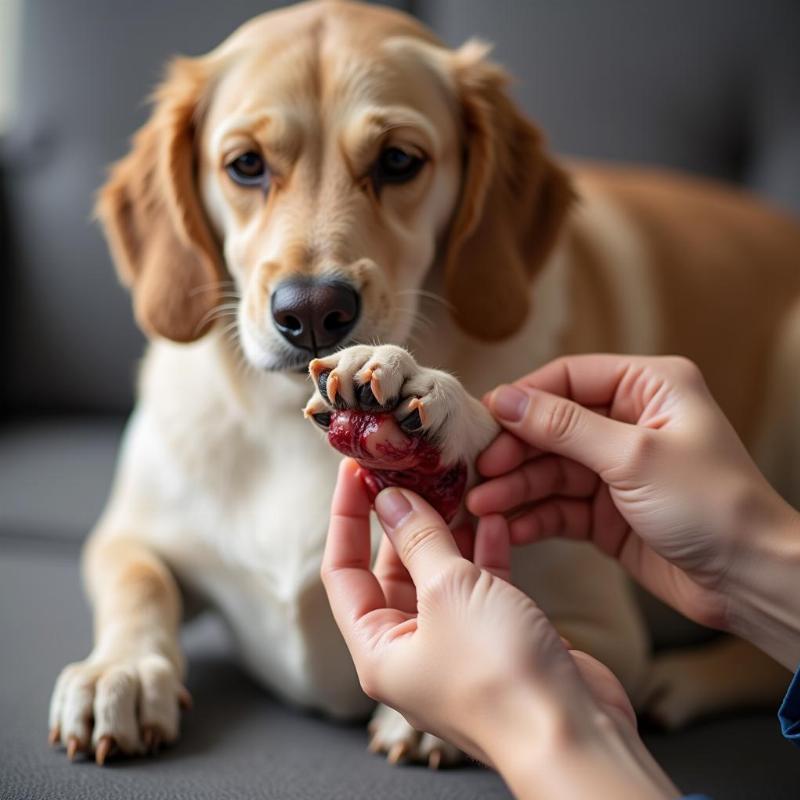If your dog cut his paw, it’s natural to feel concerned. Knowing what to do can make a big difference in your furry friend’s comfort and recovery. This guide provides practical, vet-approved advice for handling paw injuries in dogs, covering everything from assessing the cut to preventing infections and ensuring proper healing. Whether it’s a minor scrape or a deeper wound, we’ll walk you through the steps to take when your dog cuts his paw.
Assessing the Paw Injury
First, take a deep breath and try to remain calm. Your dog will pick up on your anxiety. Gently restrain your dog and examine the paw. Is it a minor scrape, a deep laceration, or something in between? Look for foreign objects like glass or thorns. Note any bleeding, swelling, or signs of infection.
 Checking a dog's paw injury
Checking a dog's paw injury
Cleaning and Disinfecting the Wound
For minor cuts and scrapes, clean the wound with warm water and mild soap. Avoid using hydrogen peroxide or alcohol, as these can damage the tissue and delay healing. Pat the area dry with a clean towel. You can apply an antiseptic solution like diluted povidone-iodine or chlorhexidine if recommended by your veterinarian.
Bandaging the Paw
If the cut is bleeding, apply pressure with a clean cloth or gauze. Once the bleeding stops, you can bandage the paw. Use a non-stick pad and wrap it with gauze or a self-adhesive bandage. Ensure the bandage isn’t too tight, as this can restrict blood flow.
When to Seek Veterinary Care
While minor cuts can often be treated at home, deeper wounds, punctures, or injuries involving joints or tendons require veterinary attention. Signs of infection, like pus, redness, swelling, and increased pain, also warrant a vet visit. If the bleeding doesn’t stop after applying pressure for several minutes, seek immediate veterinary care.
Preventing Infection and Promoting Healing
Keep the bandage clean and dry. Change it daily or as directed by your vet. Use an Elizabethan collar (cone) to prevent your dog from licking or chewing the wound. Monitor the wound for any signs of infection. Your veterinarian might prescribe antibiotics if necessary. Providing a comfortable and clean environment can help your dog recover faster.
Pain Management for Paw Injuries
Your veterinarian might recommend pain medication for your dog’s paw injury. Never give your dog human pain relievers, as many are toxic to dogs. Always follow your vet’s instructions regarding pain management.
How to Prevent Future Paw Injuries
Regularly check your dog’s paws for cuts, thorns, or foreign objects. Keep your yard free of debris and sharp objects. Trim your dog’s nails to prevent them from catching and tearing. Use booties to protect your dog’s paws in extreme weather conditions or when walking on rough terrain.
Conclusion
Knowing what to do when your dog cuts his paw can help you provide immediate care and ensure proper healing. While minor cuts can often be managed at home, seeking professional veterinary advice is crucial for deeper wounds or signs of infection. By taking prompt action and following the steps outlined in this guide, you can help your furry friend recover quickly and comfortably. Remember to monitor the wound closely and contact your vet if you have any concerns.
FAQ
- What should I do if my dog’s paw cut is bleeding heavily? Apply direct pressure with a clean cloth and seek immediate veterinary attention.
- Can I use Neosporin on my dog’s paw cut? While some formulations are safe, it’s best to consult with your veterinarian before using any over-the-counter medications.
- How long does it take for a dog’s paw cut to heal? Healing time varies depending on the severity of the cut, but it typically takes a few weeks.
- How can I prevent my dog from licking his paw wound? Use an Elizabethan collar (cone) to prevent licking and chewing.
- What are the signs of infection in a dog’s paw cut? Redness, swelling, pus, increased pain, and a foul odor are signs of infection.
- Should I take my dog to the vet for a small cut on his paw? If the cut is superficial and stops bleeding quickly, you can likely treat it at home. However, it’s always best to err on the side of caution and consult with your veterinarian, especially if you have any concerns.
- Can my dog walk on a cut paw? It’s best to limit your dog’s activity and prevent him from running or jumping while the wound heals.
Related Articles
Beautdogs.us is your trusted resource for all things dog-related in the United States. We offer expert advice on dog breeds, dog care, and product recommendations. Whether you’re a new dog owner or a seasoned pro, Beautdogs.us provides comprehensive and reliable information to help you give your furry friend the best possible care. For any questions or concerns, please reach out to us at [email protected] or call us at +1 501-555-7529. We’re here to help you navigate the wonderful world of dog ownership.